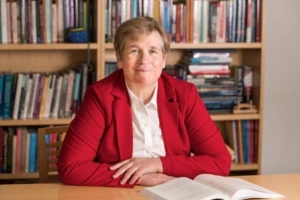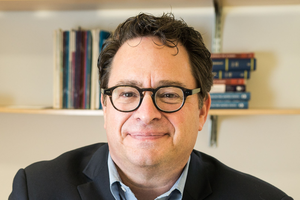Media Contacts
Kat Stein, Executive Director of Communications, Penn GSE
215-898-9642 | katstein@upenn.edu
Faculty Expert
*Note for TV and radio: The University of Pennsylvania has an on-campus ISDN line and ready access to a satellite uplink facility with live-shot capability.
WASHINGTON, D.C. (May 19, 2021) –The Pell Institute for the Study of Opportunity in Higher Education of the Council for Opportunity in Education (COE) and the University of Pennsylvania Alliance for Higher Education and Democracy (PennAHEAD) announce the release of Indicators of Higher Education Equity in the United States: 2021 Historical Trend Report. A virtual release event will be held on May 19th and will be accompanied by Shared Solutions Dialogues of policy options designed to address the equity issues raised by the statistics tracked in the Indicators report.
This year the focus of the virtual release event will be on the statistics and the stories of nontraditional students (financially independent adult students) who delayed enrollment after high school or are returning to college. The virtual event will include an overview of the 2021 Indicators report; and will feature nontraditional students’ stories, followed by breakout Shared Solutions Dialogues.
The statistics in the Indicators report reveal that nontraditional students have many risk factors and financial barriers to navigate to successful completion of their educational goals. Striking statistics on nontraditional students include:
- Large Number of College Success Risk Factors. Eighty (80) percent of independent students are enrolled part-time; 43 percent have dependent children and 28 percent are single parents; 41 percent work full time or 35 or more hours per week; and 54 percent have delayed enrollment (Indicators 1k(i) and 1k(vi)).
- Most Independent Students with Dependents are Pell Recipients. About 60 percent of Independent students with dependents have Pell grants and 41 percent without dependents have Pell grants. Among dependent students, 39 percent have Pell grants. (Indicator 2h(i))
- Most are Enrolled in Less Than 4-year Institutions. About 40 percent are enrolled in public 2-year institutions, and about 25 percent are in private for-profit or other unclassified institutions. About 30 percent of independent students with dependents and 40 percent of independent students without dependents are in 4-year institutions (Indicator 2h(ii)).
- Most Are Enrolled in Less Resourced Institutions with Low Spending per FTE Student. Over 80 percent of independent students with dependents and over 70 percent of independent students without dependents were in Broad Access (open or non-selective) 2-year or 4-year institutions (Indicator 1i(i)). The average spending per FTE enrolled student in Broad Access institutions was $14,945 compared with $52,111 at Highly Selective Institutions (Indicator 3d(ii)).
- High Levels of Unmet Need. Independent students with dependents averaged $17,112 per year in unmet need in 2019 dollars and independent students without dependents averaged $16,658 in unmet need. These levels are almost twice (1.9 times) the average for dependent students ($9,052) (Indicator 3cii).
- Half will Not Have Earned any Degree or Certificate by 6 Years. Considering all independent beginning students including those seeking below 2-year certificates as well as those entering 2-year and 4-year programs, the Beginning Postsecondary Study (BPS) found that 9 percent will have attained a bachelor’s degree and 38 percent will have obtained some form of a degree or certificate by 6-years after first enrolling; Another 13 percent will still be enrolled, and 49 percent will not be enrolled and will not have obtained any degree or certificate. Considering first time independent students entering degree programs at 4-year or 2-year colleges (excluding those entering below 2-year certificate programs), 21 percent will have obtained a bachelor’s degree after 6 years compared with 45 percent of dependent students (Indicator 5c(iv) and 5c(i)).
- In Order to Graduate, High Debt Is Incurred. Among the small percentage of independent students who obtain a bachelor’s degree, the Baccalaureate and Beyond (B&B) study of students graduating in 2016 found that almost three-fourths (72 percent) of independent students have borrowed. When interviewed one year later, the average amount borrowed was $35,670 compared with $28,786 for dependent students (Indicator 4e(ii)).
Once known for wide accessibility to and excellence within its higher education system, the U.S. now has an educational system that sorts students in ways that have profound implications for later life chances. This sorting system of higher education may be fostering the societal inequality it is designed to mitigate.
“The inescapable conclusion considering the statistics in the report is that the U.S. higher education system is deeply segregated by parental socio-economic status and by race and ethnicity. This has resulted in a cost and funding structure that provides almost insurmountable barriers for nontraditional, low-income and students of color to overcome,” says Margaret Cahalan, director of the Pell Institute and co-author of the report.
“It is an overly competitive system, that ends up producing highly resourced monocultured institutions serving a small percentage of students who are highly resourced academically and financially. At the same time most low-income students with far less academic and financial resources are in poorly funded institutions and must incur large amounts of debt for their education.”
“We have seen so many proposals for free college and debt relief in the past year, even amidst a pandemic, because the painfully high cost of a degree is stifling another generation of young people and continuing to shut out minority and low-income Americans. These data show why we need change,” says Laura Perna, vice provost of the University of Pennsylvania and co-founder of the Equity Indicators project.
Some other key findings include:
- Pell Recipients Tend to Be in Low Resourced Institutions. On average poor students attend institutions with far fewer resources than rich students. In 2018, 63 percent of Pell grant recipients were in Broad Access colleges with average spending per FTE of $14,945 while 5 percent of Pell grant recipients were in Highly Selective institutions with average spending of $52,111. In general, as selectivity increases, Pell receipt declines (Indicators 3d(ii)).
- Stratification by Family SES is High. The most recent NCES high school longitudinal study found that among 2009 9th graders who graduated from high school in 2013, those from the highest SES quintile were 8 times as likely to attend a “most” or “highly” selective 4-year college as students from the lower SES quintile (33 percent versus 4 percent) (Indicator 2f).
- Race/Ethnicity Differences in Types of Colleges Attended. White high school completers were over 3 times more likely to attend a Most or Highly Selective 4-year institution as Blacks (5 percent vs.17 percent) (Indicator 2g).
- Increasingly Low Levels of Pell grant Support Relative to College Cost Over Time. The maximum Federal Pell grant covered 68 percent of average college costs in 1975-76, but only 25 percent of average college costs in 2018-19. If it had covered two-thirds of average college costs, the maximum Federal Pell grant would have been $16,497 rather than $6,205 in 2018-19 (Indicator 3b(ii)).
- Black-White Debt-Gap Grows After Graduation. Ten years after completing their bachelor’s degrees, 86 percent of Blacks had borrowed for undergraduate or graduate education, compared with 71 percent of Whites. The debt gap between Blacks and Whites has risen to $28,107 in 2019 dollars, with Blacks borrowing an average of $62,824 and Whites borrowing an average of $34,717(Indicator 4e(iv a & b).
- Intergenerational Black-White Debt and Wealth Gaps Have Life-Long Consequences. Starkly, 10 years after being awarded their bachelor’s degree, over one third (37 percent) of Black bachelor’s graduates had negative net worth, and 29 percent indicated they had difficulty meeting essential living expenses in the previous 12 months. For White bachelor’s graduates, the comparable rates were 18 percent with negative net worth and 11 percent who reported having difficulty meeting essential monthly expenses (Indicator 4e(vii)).
- Completion Rates Strongly Linked to Socioeconomic Status (SES). Dependent students who enrolled in college in 2011-12 who were both low-income and the first generation in their families to attend college (first-generation) were found to have about a 21 percent chance of completing a bachelor’s degree in 6-years compared with a 66 percent chance among students who were not low-income or first-generation (Indicator 5cii).
- Differences across U.S. States in Education Attainment Are Growing. Differences in bachelor’s degree attainment have increased substantially over the 79-year period from 1940 to 2019 (Indicator 5f(i). By 2019, 11 states had bachelor’s degree attainment rates for the population age 25 to 34 above 40 percent (Vermont, Virginia, Rhode Island, Illinois, Minnesota, Maryland, Colorado, Connecticut, New York, New Jersey, and Massachusetts). Three states had bachelor’s degree attainment rates below 25 percent for that population (Nevada, New Mexico, and Mississippi) (Indicator 5f(v).
- TRIO Services Found to Substantially Increase Access and Completion, but TRIO reached only fraction of eligible students each year. In 2020, an estimated 808,545 students participated in one of the 7 Federal TRIO programs. National studies have shown that participation in TRIO substantially increases college entrance, persistence, completion, and graduate school enrollment among low-income, first-generation, and students with disabilities. Given current funding levels, TRIO reaches only about 1 percent of the eligible population for the more intensive TRIO programs and only about 3 percent for the more extensive outreach programs in any given year (Indicators 7 (a(i)-d(v)).
This year the Shared Dialogues focuses on students who may have been sorted out or opted out of attending college right after high school or who did not complete college and are now returning to college.
In 2019 these non-traditional students constituted fully half (50 percent) of all undergraduate enrollment. While half of independent students are White, students of color are overrepresented as are students who are low-income and the first in their family to attend college. Some have already exhausted their Pell grants or were disqualified for Pell grants by not showing sufficient academic progress (SAP) to complete a degree in 150 percent of program length.
The goal of the Equity Indicators project is to provide a tool for stakeholders (students, scholars, advocates, policy makers and the public) to look at higher education statistics from an equity perspective, and to engage in dialogues designed to consider actionable public policies focused on attaining greater equity within higher education. The report covers historical trends as far back as the data warrant often from the 1970s on questions of student access, institutional stratification, college cost, funding per student, student debt, college completion and attainment, international comparisons, and federal TRIO services.
This report and release event are the seventh in a series of historical trend reports and accompanying Shared Solutions Dialogues.
The Pell Institute conducts and disseminates research and policy analysis to encourage policymakers, educators, and the public to improve educational opportunities and outcomes for low-income, first-generation college students and students with disabilities. It is the research arm of the Council for Opportunity in Education, a nonprofit organization established in 1981 that is dedicated to furthering the expansion of college opportunities for low-income, first-generation students, and students with disabilities.
PennAHEAD is dedicated to fostering open, equitable, and democratic societies through higher education. Located within the Graduate School of Education of the University of Pennsylvania, PennAHEAD conducts original research and applies a multidisciplinary, research-based approach to address the most pressing issues regarding the societal contributions of higher education in the United States and the world.
Media Inquiries
Penn GSE Communications is here to help reporters connect with the education experts they need.







